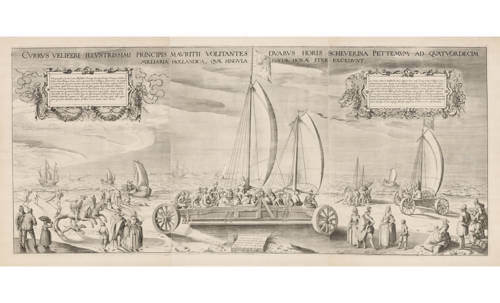Leen Helmink Antique Maps
Old books, maps and prints by Jacques de Gheyn II
Jacques de Gheyn II (c. 1565–1629)
Jacques de Gheyn II (c. 1565–1629) was a pivotal figure in the Dutch Golden Age, celebrated as a painter, engraver, and draftsman whose work bridged the ornate Northern Mannerism of the late 16th century with the emerging realism of Dutch art. Born in Antwerp to a glass painter and engraver, Jacques de Gheyn I, he developed an early aptitude for art, later honing his skills under the tutelage of Hendrick Goltzius in Haarlem from 1585 to 1590. De Gheyn’s career, spanning Antwerp, Haarlem, Leiden, and The Hague, was marked by versatility, innovation, and close ties to the House of Orange, particularly Prince Maurits. His oeuvre includes some of the earliest vanitas still lifes, floral studies, and female nudes in Dutch art, alongside over 1,500 drawings and numerous engravings. Among his most notable works is the monumental three-sheet engraving of Prins Maurits’ Land Yaght, a testament to his skill and his role in documenting Dutch ingenuity and princely ambition.
De Gheyn’s early training under his father and Goltzius instilled a meticulous approach to engraving, evident in his first major commission in 1593: an engraving of the Siege of Geertruidenberg for Prince Maurits, which served as propaganda to bolster the prince’s reputation as a military leader. By the mid-1590s, De Gheyn settled in Leiden, where he collaborated with the scholar Hugo Grotius, producing engravings for Grotius’ Syntagma Arateorum (1600), which illustrated constellations with precision. His marriage to Eva Stalpaert van der Wiele in 1595, a wealthy woman from Mechelen, provided financial stability, enabling him to pursue ambitious projects. Around 1600, De Gheyn shifted focus from engraving to painting and etching, creating works like the Vanitas Still Life (1603, Metropolitan Museum of Art), considered the earliest of its kind in the Netherlands. In 1605, he moved to The Hague, where he became a favored artist of the Dutch court, joining the Guild of St. Luke and designing innovative gardens for Prince Maurits, including the Buitenhof garden with the Netherlands’ first grottoes.
De Gheyn’s monumental three-sheet engraving, Prins Maurits’ Land Yaght (c. 1602–1603, Rijksmuseum), is a highlight of his career, though its attribution remains debated. This expansive print, measuring approximately 45 inches across, depicts a historic event: Prince Maurits and 27 guests sailing in two land yachts, or “sand chariots,” designed by Simon Stevin, from Scheveningen to Petten in 1602. The land yacht, a wind-powered vehicle, symbolized Dutch technological prowess during the war of independence against Spain. The engraving captures the yacht in motion, with billowing sails, detailed rigging, and a retinue of figures, set against a coastal landscape. Its scale and complexity reflect De Gheyn’s technical virtuosity, likely executed in collaboration with Willem Isaacszoon van Swanenburg, to whom the Rijksmuseum attributes the work, though some sources suggest De Gheyn’s design was central. The print served as both a scientific record and a celebration of Maurits’ patronage, aligning with De Gheyn’s role in promoting the prince’s image, as seen in earlier works like the Exercise of Armes (1607), a military manual with 117 engravings commissioned by Maurits.
De Gheyn’s broader contributions to Dutch art were profound. His drawings, ranging from natural history studies to landscapes, showcase his curiosity and versatility, with over 1,500 attributed to him. His engravings, such as the portrait of Tycho Brahe for Astronomiae instauratae mechanica (1602) and Carolus Clusius for Rariorum plantarum historia (1601), demonstrate his skill in scientific illustration. Paintings like the Spanish Warhorse (1603, Rijksmuseum), depicting a horse captured during the Battle of Nieuwpoort and presented to Maurits, highlight his ability to imbue historical subjects with grandeur. Unlike many contemporaries, De Gheyn never traveled to Italy, and his work shows minimal influence from classical antiquity, except in his garden designs. His shift toward Calvinism, despite a Catholic upbringing, and his engagement with Leiden’s intellectual circles further shaped his subject matter, which often blended reality and imagination, as noted by Karel van Mander.
On a personal level, De Gheyn was a respected figure in The Hague, where he died on March 29, 1629. His son, Jacob de Gheyn III, born in 1596, followed in his footsteps as an engraver and was famously portrayed by Rembrandt in 1632 alongside Maurits Huygens, reflecting the family’s cultural prominence. De Gheyn’s connections with the Huygens family and Prince Frederick Henry, Maurits’ successor, underscore his integration into elite Dutch society. His work for the House of Orange, from garden designs to engravings, cemented his legacy as an artist who not only documented but also shaped the visual culture of the Dutch Republic.
The Prins Maurits’ Land Yaght engraving encapsulates De Gheyn’s ability to merge art, science, and politics. Its monumental scale and detailed execution made it a celebrated image of Dutch innovation, while its debated attribution highlights the collaborative nature of printmaking in the period. De Gheyn’s broader oeuvre, from vanitas still lifes to military manuals, reflects the dynamic cultural and intellectual currents of the Dutch Golden Age. His legacy endures in collections like the Rijksmuseum, the Metropolitan Museum of Art, and the Getty, where his works continue to illuminate the transition from Mannerism to realism and the vibrancy of 17th-century Dutch art.
Sources
Rijksmuseum: Jacques de Gheyn II, Spanish Warhorse and Land Yaght
The Metropolitan Museum of Art: Jacques de Gheyn II, Vanitas Still Life
Linda Hall Library: Jacques de Gheyn II, Scientific Engravings
Wikipedia: Jacques de Gheyn II
Dayton Art Institute: Jacques de Gheyn II Biography
